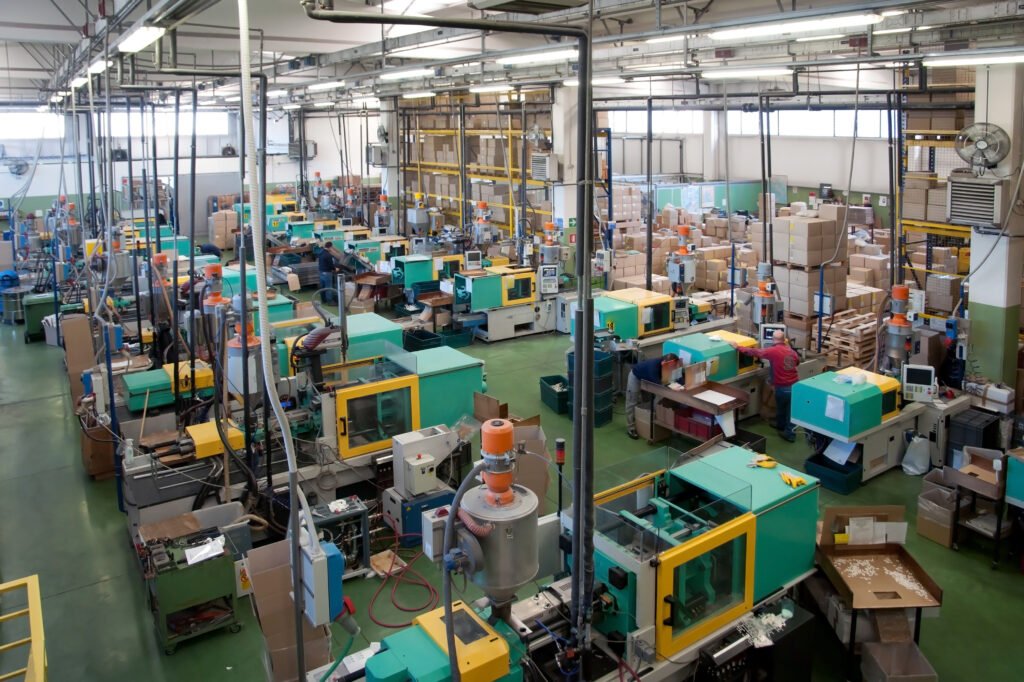Injection Moulding Machine technology continues to evolve, offering efficient ways to manufacture plastic products. Setting up your injection molding machine correctly is crucial for achieving optimal production results. Follow these steps to ensure a smooth setup process

1. Preparation
a. Gather Necessary Tools and Equipment
- Tools: Adjustable wrench, screwdrivers, mold clamps, safety gloves, mold heater (if required).
- Materials: Injection mold, plastic resin pellets, mold release agent.
b. Review Safety Protocols
- Familiarize yourself and your team with safety procedures and guidelines.
- Ensure proper ventilation and use of personal protective equipment (PPE) during setup and operation.
2. Installation Area Preparation
a. Choose an Adequate Space
- Select a clean, well-ventilated area with sufficient space for the injection molding machine and auxiliary equipment.
- Ensure the floor is level and capable of supporting the machine’s weight.
b. Electrical and Utility Requirements
- Verify that electrical outlets and voltage meet the machine’s specifications.
- Arrange for adequate water supply and drainage, if required for machine cooling or mold temperature control.
3. Machine Setup
a. Unpacking and Positioning
- Carefully unpack the injection molding machine components and inspect for any shipping damage.
- Position the machine according to manufacturer guidelines, ensuring access for maintenance and operation.
b. Leveling and Alignment
- Use a level to ensure the machine is perfectly horizontal and stable.
- Align the machine with the mold clamping area and ensure proper clearance for mold installation.
4. Mold Installation
a. Prepare the Injection Mold
- Clean and inspect the injection mold for any damage or debris.
- Apply mold release agent to ensure smooth ejection of molded parts.
b. Mounting the Mold
- Securely attach the mold to the machine’s platens using appropriate mold clamps.
- Follow the recommended torque specifications to avoid over-tightening or under-tightening.
5. Connect Utilities
a. Electrical Connections
- Connect the machine to the power source, following electrical safety protocols.
- Test electrical components such as heating elements, motors, and control panels for proper functionality.
b. Water and Air Connections
- If applicable, connect water lines for mold cooling and air lines for pneumatic controls.
- Check for leaks and ensure adequate flow rates as per machine specifications.
6. Setup Machine Parameters
a. Injection Settings
- Set injection pressure, injection speed, and injection time based on material requirements and part specifications.
- Program the machine’s controller to achieve optimal molding conditions.
b. Temperature Control
- Configure mold temperature settings for both heating and cooling zones, if applicable.
- Monitor and adjust temperatures to achieve consistent part quality and cycle times.
7. Initial Testing and Calibration
a. Dry Run
- Perform a dry run or manual cycle to check machine movements and mold alignment.
- Verify that all safety features, including emergency stop buttons, are functional.
b. Trial Molding
- Inject a test shot of plastic resin into the mold to validate setup parameters.
- Inspect the molded part for defects, dimensions, and quality.
8. Fine-tuning and Optimization
a. Adjust Settings
- Make necessary adjustments to injection pressure, temperature, and cycle times based on trial molding results.
- Optimize settings to achieve desired part quality and production efficiency.
b. Documentation
- Record setup parameters, trial results, and any adjustments made during setup.
- Maintain a setup log for reference and future troubleshooting.
9. Operator Training
a. Training Sessions
- Provide training to machine operators on operation procedures, maintenance tasks, and troubleshooting techniques.
- Emphasize safety protocols and proper use of machine controls.
b. Continuous Improvement
- Encourage feedback from operators to identify opportunities for process improvement and efficiency gains.
- Implement best practices and standard operating procedures (SOPs) to streamline operations.
10. Production Readiness
a. Production Planning
- Develop a production schedule based on machine capabilities and customer demand.
- Coordinate material supply and workforce availability to maximize machine utilization.
b. Quality Assurance Checks
- Implement quality control measures to ensure consistent part quality.
- Conduct initial sample inspections and dimensional checks to verify conformance to specifications.
11. Maintenance and Calibration
a. Regular Maintenance Schedule
- Establish a maintenance schedule for routine checks, lubrication, and component inspections.
- Follow manufacturer guidelines for replacing wear parts and servicing critical components.
b. Calibration of Sensors and Controls
- Periodically calibrate machine sensors, temperature controllers, and pressure gauges.
- Ensure accurate measurement and control of process parameters for reliable production.
12. Continuous Monitoring and Optimization
a. Real-time Monitoring
- Utilize machine monitoring systems to track key performance indicators (KPIs) such as cycle time, reject rate, and energy consumption.
- Identify trends and deviations to implement proactive adjustments and optimizations.
b. Process Optimization
- Analyze production data to identify opportunities for cycle time reduction, material savings, and scrap reduction.
- Implement lean manufacturing principles and continuous improvement initiatives to enhance efficiency.
13. Environmental and Safety Considerations
a. Environmental Responsibility
- Implement sustainable practices such as energy-efficient operations and waste reduction strategies.
- Comply with environmental regulations and promote responsible disposal of waste materials.
b. Operator Safety
- Provide ongoing training on machine safety protocols and emergency procedures.
- Ensure operators have access to personal protective equipment (PPE) and ergonomic workstations.
Conclusion
Setting up an injection molding machine involves meticulous planning, attention to detail, and adherence to safety and operational protocols. By following this step-by-step guide, manufacturers can ensure a smooth and efficient setup process, laying the foundation for consistent production of high-quality plastic parts in 2024 and beyond.




|
If you’re a homeowner looking to get a loan, a secured loan could be a sensible option. Leverage better rates by using your home as collateral.
Unlock the equity in your property with a secure home equity loan — ideal for covering home improvements, large expenses, or debt consolidation.
If you’re a homeowner looking to get a loan, a secured loan could be a sensible option. Leverage better rates by using your home as security.
Thinking about a loan against your home to consolidate your financial obligations? Find out more and check what solutions may be available to you.
If you’re a property owner looking to get a loan, a secured loan could be a sensible option. Access better rates by using your home as security.
Explore how a secured loan can help you obtain the money you need without selling your home. Review lenders and customise a plan that fits your needs.
I particularly admired the approach this was presented.
I truly liked the style this was written.
Thanks for creating this. It’s well done.
This submission is valuable.
More articles like this would make the blogosphere richer.
Such a informative bit of content.
Such a valuable resource.
You’ve evidently done your homework.
Such a informative insight.
Such a informative resource.
This is the kind of post I value most.
I discovered useful points from this.
This write-up is informative.
Such a useful resource.
The depth in this article is noteworthy.
I’ll surely return to read more.
I’ll certainly return to read more.
Such a beneficial read.
Such a practical insight.
Such a informative insight.
The breadth in this piece is noteworthy.
I particularly appreciated the style this was written.
Such a beneficial read.
Thanks for putting this up. It’s well done.
This write-up is amazing.
The thoroughness in this article is noteworthy.
This piece is brilliant.
This is the kind of post I enjoy reading.
More articles like this would make the web more useful.
This write-up is well-written.
I really enjoyed the approach this was presented.
I particularly valued the style this was explained.
More posts like this would make the web richer.
Thanks for publishing. It’s a solid effort.
I’ll surely be back for more.
Such a helpful resource.
Such a valuable bit of content.
Such a valuable resource.
Thanks for putting this up. It’s well done.
I’ll definitely return to read more.
More content pieces like this would make the blogosphere better.
I gained useful knowledge from this.
This is the kind of writing I look for.
Such a helpful read.
The depth in this piece is remarkable.
I genuinely liked the approach this was laid out.
I discovered useful points from this.
I absolutely appreciated the style this was explained.
I particularly valued the style this was explained.
I learned a lot from this.
This article is valuable.
This submission is informative.
I learned a lot from this.
More posts like this would make the internet richer.
More content pieces like this would make the internet better.
Such a beneficial resource.
Thanks for publishing. It’s excellent.
Such a useful bit of content.
This is the kind of writing I find helpful.
This article is outstanding.
I gained useful knowledge from this.
This is the kind of post I truly appreciate.
This is the kind of writing I value most.
I really appreciated the style this was presented.
More blogs like this would make the internet richer.
This post is excellent.
I’ll gladly be back for more.
I really admired the manner this was presented.
More articles like this would make the web better.
was ist hgh bodybuilding
References:
How Many Iu Are In 1 Mg Of Hgh (Mystery.Presscont.Cz)
winstrol effects
References:
bodybuilding supplement reviews (https://schoolido.lu/user/prisonquill3/)
how long is a dianabol cycle
References:
dianabol and testosterone cycle for Beginners (molchanovonews.ru)
test e and dianabol cycle
References:
Dianabol winstrol cycle
testosterone enanthate and dianabol cycle
References:
dianabol And Testosterone Cycle for beginners
hgh bulking cycle
References:
hgh dosierung fettverbrennung (https://jii.li/)
legal australian steroids
References:
Steroidsforsale.Com (Omkie.Com)